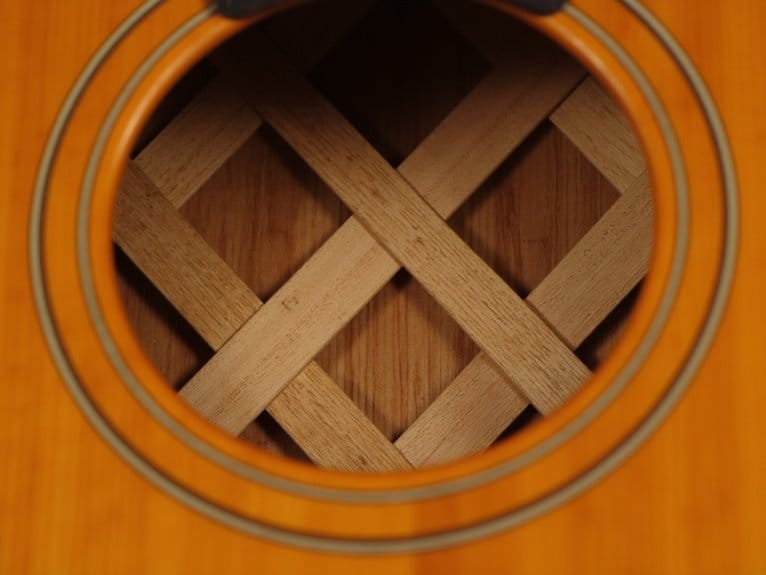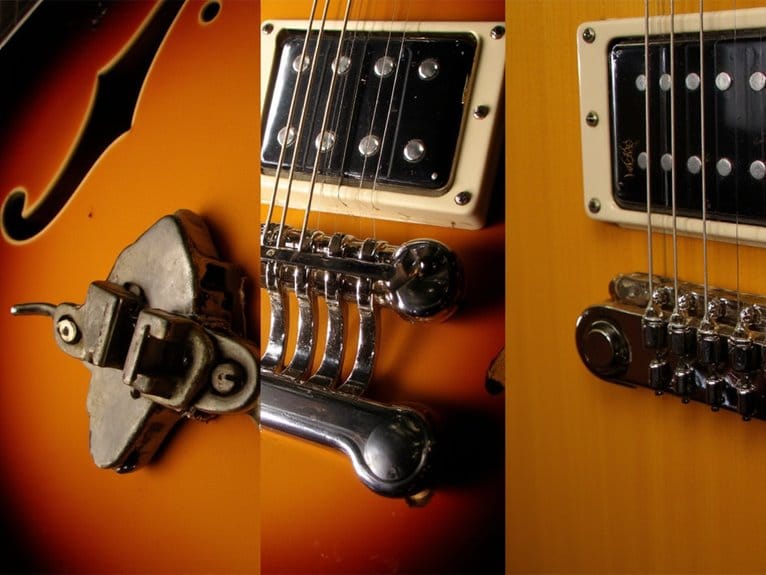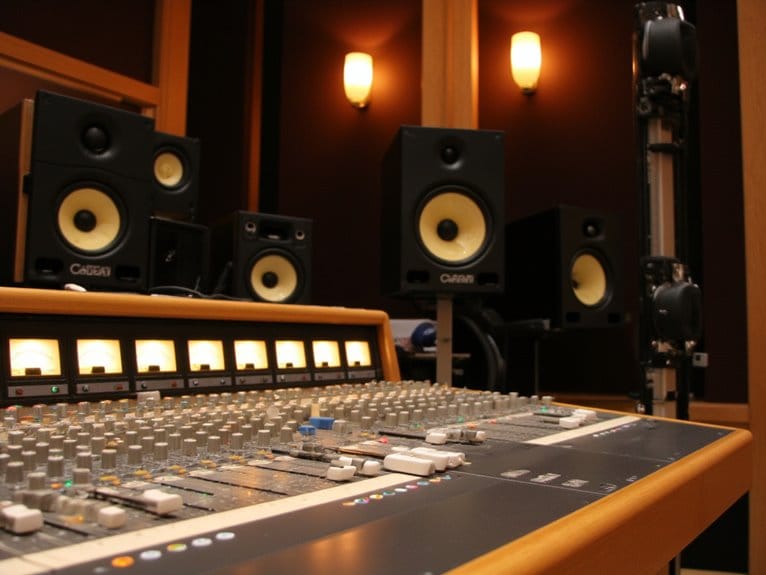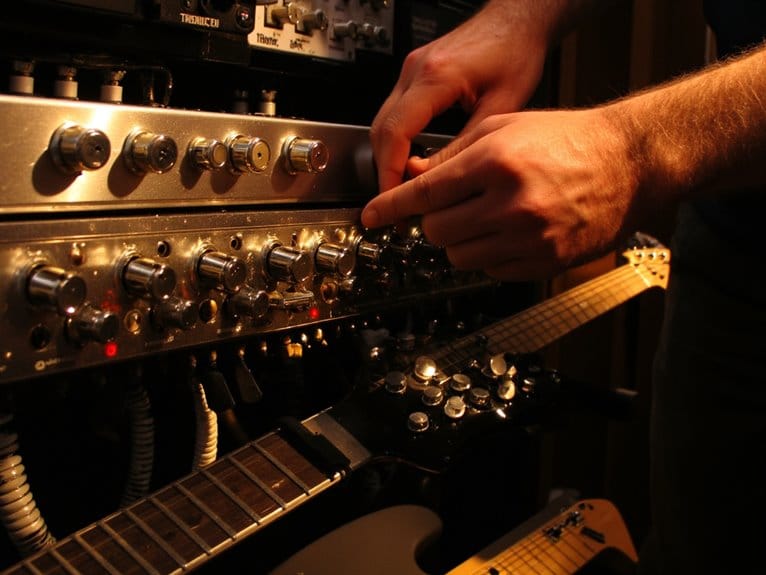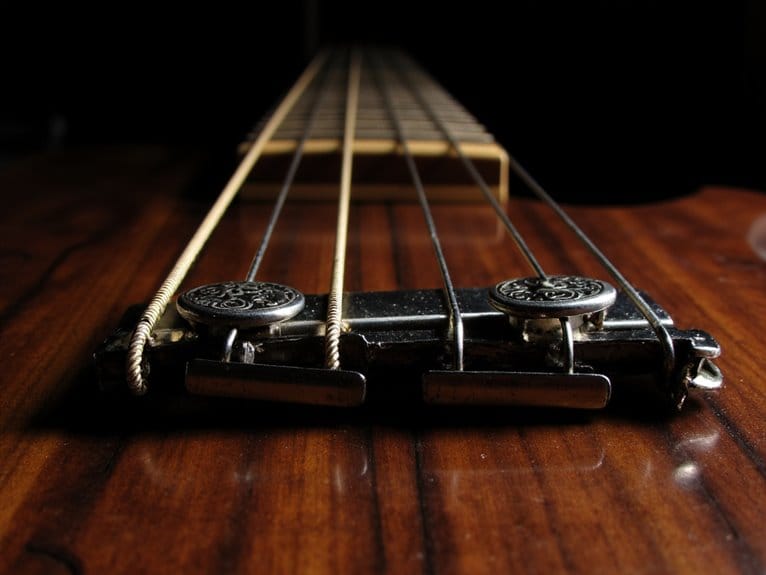Understanding Guitar Bracing Patterns and Their Effects
Guitar bracing patterns fundamentally control how your instrument’s soundboard vibrates, directly affecting tone, projection, and sustain. X-bracing dominates steel-string guitars with balanced midrange punch, while fan bracing offers classical guitars’ warm fingerstyle character. Ladder bracing delivers bright treble but limits heavy strumming capability. These internal wooden supports must balance structural integrity against string tension with acoustic responsiveness, creating zones of varying stiffness that guide vibrational energy flow. Understanding these patterns helps explain why identical guitar models can sound remarkably different, and there’s much more to explore about how construction details shape your instrument’s unique voice.
We are supported by our audience. When you purchase through links on our site, we may earn an affiliate commission, at no extra cost for you. Learn more.
Notable Insights
- Bracing systems maintain structural integrity while shaping tone, balancing stiffness and flexibility to control soundboard vibrations.
- X-bracing dominates steel-string guitars for projection, while fan bracing suits classical guitars with warmer fingerstyle tones.
- Scalloped braces create warm, bass-rich sounds through reduced mass, while straight braces produce brighter, clearer articulation.
- Wood species significantly impact tone: spruce offers brightness, mahogany provides warmth, and cedar delivers full-bodied softness.
- Forward-shifted patterns emphasize bass frequencies, while rear-shifted designs enhance treble for brighter tonal character.
The Fundamentals of Guitar Bracing Systems
When I first started building guitars decades ago, I’ll admit I underestimated how essential bracing systems are to a guitar’s structural integrity and tonal character.
I wish I’d realized sooner how dramatically bracing patterns influence every aspect of a guitar’s voice and structural stability.
But these seemingly simple wooden strips beneath the soundboard perform the complex task of preventing your guitar top from collapsing under string tension while simultaneously shaping every note you play.
Understanding bracing history reveals centuries of evolution from basic support structures to sophisticated acoustic principles that control vibration patterns like a physical filter.
Without proper bracing, your soundboard would vibrate chaotically, producing unintelligible noise rather than musical tones.
These engineering marvels balance stiffness and flexibility, determining whether you’ll experience rich sustain, clear projection, or dynamic responsiveness when you strum. The choice between thicker braces that absorb more vibrations versus lighter braces significantly affects your instrument’s bass response and overall volume projection. Modern innovations like falcate bracing employ curved wooden pieces that align symmetrically with string tension for more efficient structural support than traditional straight braces.
Popular Bracing Patterns and Their Unique Characteristics
Now that you understand why bracing matters so fundamentally, let’s examine the specific patterns that luthiers have developed over centuries, each creating distinctly different tonal personalities in your guitar.
X-bracing dominates steel-string acoustics, delivering powerful projection and balanced midrange that cuts through band mixes, while classical guitars traditionally employ fan bracing for warmer, more resonant fingerstyle tones.
Pattern comparisons reveal fascinating contrasts: ladder bracing’s simplistic horizontal bars produce bright, treble-focused sounds favored by blues players, though they can’t handle heavy strumming like X-braced guitars.
Modern innovations like falcate bracing apply engineering principles to curved designs, maximizing structural efficiency while enhancing clarity. Contemporary luthiers create hybrid patterns that combine elements from traditional systems to achieve specific sonic objectives.
This rich bracing history demonstrates how each pattern represents specific compromises between structural integrity, tonal character, and playing style requirements.
How Bracing Shapes Sound Quality and Tonal Response
You’ll find that bracing fundamentally transforms how your guitar’s soundboard vibrates, controlling which frequencies resonate clearly and which get dampened or emphasized in the overall tonal mix.
The specific profile shapes, curvature patterns, and weight distribution of these wooden supports directly influence whether your instrument produces warm, rounded tones with rich bass response or bright, articulate sounds with crisp treble definition.
Understanding these vibration control mechanisms helps explain why different bracing approaches, from traditional X-patterns to modern fan configurations, create such distinctly different tonal characters even when using identical tonewoods.
Vibration and Resonance Control
While guitar strings create the initial vibration that produces sound, it’s actually the soundboard’s controlled movement that determines whether you’ll hear crystalline notes or muddy chaos.
Through strategic placement and design, bracing systems manage vibration dynamics by creating zones of varying stiffness and flexibility across the top, which directly influences how energy travels from your pluck to your ears. This resonance control prevents the chaotic, irregular patterns that would otherwise produce noisy trebles and muddy bass response.
Proper bracing fundamentally acts as a traffic controller for vibrational energy, directing it through predetermined pathways while maintaining structural integrity against string tension.
Without this control, even premium tonewoods would generate unmusical noise rather than the coherent, balanced sound that defines quality acoustic guitars.
Tonal Character Differences
Beyond controlling mere vibration patterns, bracing fundamentally sculpts your guitar’s voice, transforming the same piece of wood into instruments with dramatically different personalities.
Scalloped braces create warm, bass-rich tones by reducing mass and allowing freer top movement, while straight braces produce brighter, more articulate sounds with less warmth but greater clarity. The tone variation between these approaches is remarkable—you’ll hear the difference immediately when comparing guitars side by side.
Forward-shifted bracing enhances lower frequencies for warmer character, whereas rear-shifted patterns emphasize trebles for brightness. This resonance impact extends beyond simple frequency response, affecting sustain, projection, and harmonic complexity, allowing luthiers to deliberately craft instruments that excel in specific musical contexts and playing styles.
Structural Support and String Tension Management
When I first started building guitars, I honestly underestimated how much engineering goes into what seems like a simple wooden box.
But the bracing pattern you choose determines whether your instrument will hold up under string tension or collapse like a house of cards. Steel strings generate tremendous force—we’re talking about 150-200 pounds of combined tension pulling constantly at your soundboard, which explains why X-bracing became the gold standard for steel-string acoustics.
The brace tension must counteract this pull while allowing the top to vibrate freely, creating a delicate balance between structural integrity and tonal response. Proper load distribution spreads these forces across multiple braces, preventing catastrophic failure at stress concentration points around the bridge and soundhole where tension peaks.
Material Selection and Construction Techniques
When you’re selecting materials for your guitar braces, the wood species you choose will fundamentally shape your instrument’s tonal character, with spruce leading as the gold standard due to its exceptional stiffness-to-weight ratio that I’ve relied on for countless builds.
Your construction approach, particularly how you scallop and shape these braces, determines whether you’ll achieve that perfect balance between structural integrity and vibrant responsiveness that separates mediocre guitars from exceptional ones.
The eternal challenge you’ll face lies in managing the mass-versus-strength equation, where every gram of material must earn its place through either acoustic contribution or structural necessity.
Mahogany offers an excellent alternative bracing material, providing warm mid-range frequencies and superior resonance that develops greater tonal complexity over time.
Similar to how drum shells utilize multi-ply poplar construction to achieve rich tones while maintaining lightweight properties, guitar bracing must balance resonance with structural stability.
Wood Types for Braces
| Wood Type | Primary Use | Tonal Character | Density | Best Application |
|---|---|---|---|---|
| Spruce | Top braces | Bright, articulate | Light | Steel-string guitars |
| Mahogany | Back braces | Warm, rich midrange | Medium | Classical models |
| Maple | Top/back braces | Maple clarity, focused | Medium-heavy | Precision instruments |
| Cedar | Back braces | Full-bodied, soft | Light-medium | Cedar-top pairings |
| Redwood | Specialty bracing | Redwood blend of brightness/warmth | Medium | Custom designs |
Quarter-sawn preparation maximizes grain stability while proper seasoning prevents future warping issues.
Scalloping and Shaping Methods
While selecting the right wood species provides the foundation for tonal character, the way you shape and sculpt those braces determines how effectively they’ll transmit vibrations through your guitar’s soundboard.
Scalloping techniques involve carefully shaving material from braces to reduce mass and increase flexibility, which enhances responsiveness and creates that coveted bass-rich, dynamic tone with more volume.
You’ll find three primary approaches: scalloped braces feature scooped-out, parabolic shapes for maximum tonal flexibility, shaved braces offer subtle material removal with better strength retention, and non-scalloped braces maintain full mass for tighter, more focused output.
The trade-off’s straightforward—aggressive brace shaping delivers enhanced tone but sacrifices structural integrity, while conservative approaches prioritize durability over acoustic responsiveness.
Mass Versus Strength Balance
Beyond shaping techniques lies an equally critical challenge that’ll make or break your guitar’s acoustic performance—finding that sweet spot between structural strength and mass that determines whether your instrument sings with clarity or sounds muffled and lifeless.
You’re dealing with approximately 10Nm of string tension that demands robust support, yet excessive brace weight kills your soundboard’s vibrational freedom. The secret lies in strategic mass distribution using lightweight conifers like European spruce or cedar, quartersaw-cut for maximum stiffness-to-weight ratios.
Smart brace geometry, whether X-pattern or innovative V-Class designs, concentrates strength precisely where tension loads demand it while preserving acoustic flexibility elsewhere. This calculated approach delivers structural integrity without sacrificing the responsive, dynamic tone that separates great guitars from mediocre ones.
Frequently Asked Questions
Do Humidity Changes Affect Different Bracing Patterns Differently?
Yes, humidity effects vary considerably between bracing patterns. X-bracing allows more top movement, while alternative patterns like V-Class provide different bracing stability. Carbon fiber reinforcements minimize humidity-driven changes regardless of pattern type you’re using.
Can Bracing Patterns Be Combined or Hybridized in One Guitar?
You can absolutely combine bracing patterns in custom bracing designs. Hybrid systems like Martin’s A Frame/X combination offer unique tonal enhancements, blending warmth with projection by strategically placing different braces across the guitar’s top.
On a final note
You’ll find that understanding bracing patterns transforms how you approach guitar selection, whether you’re drawn to the warm resonance of X-bracing, the clarity of ladder bracing, or modern innovations like scalloped supports. Your playing style, preferred genres, and tonal preferences should guide your choice, since each pattern offers distinct characteristics in volume projection, sustain, and frequency response that’ll directly impact your musical expression and overall satisfaction.

